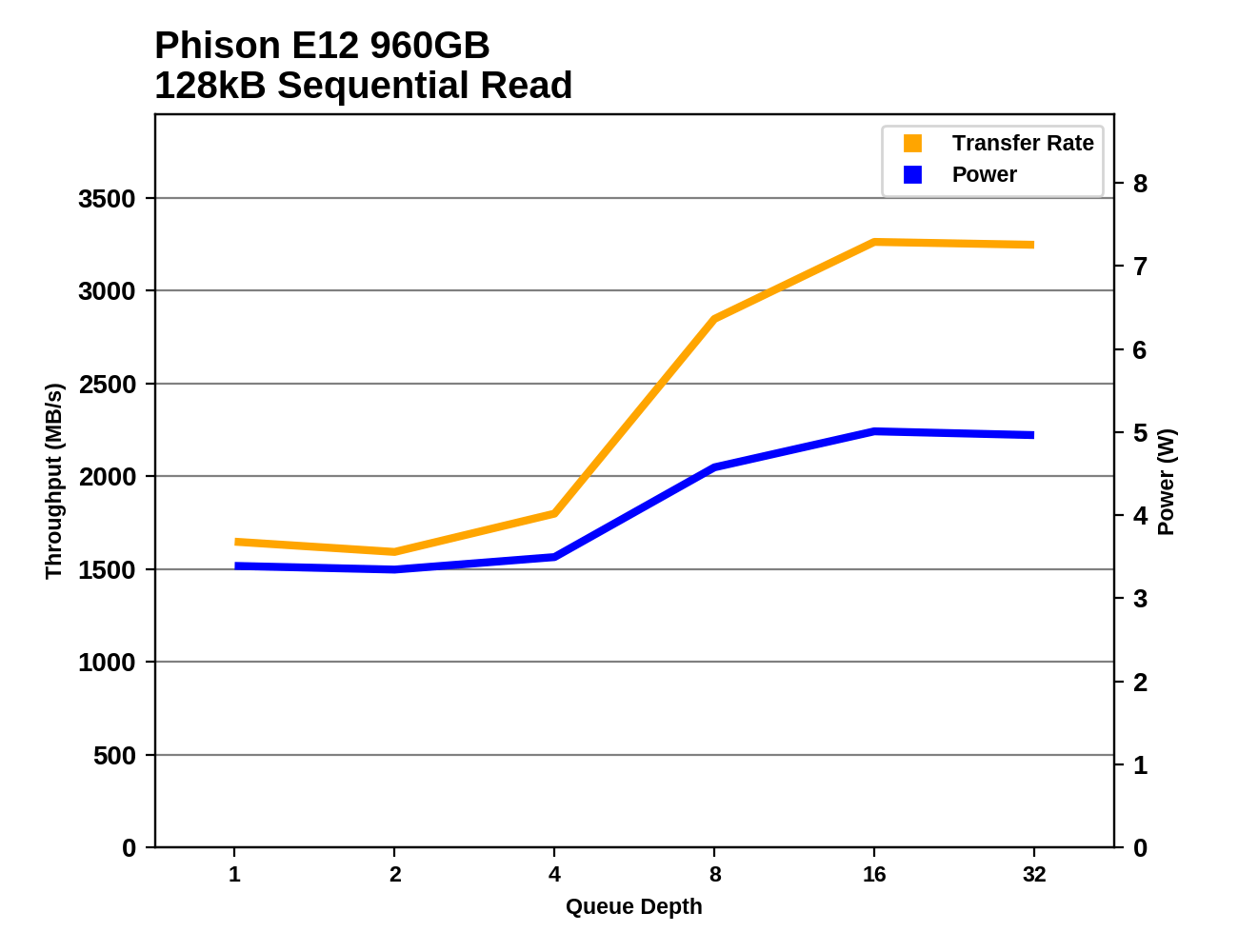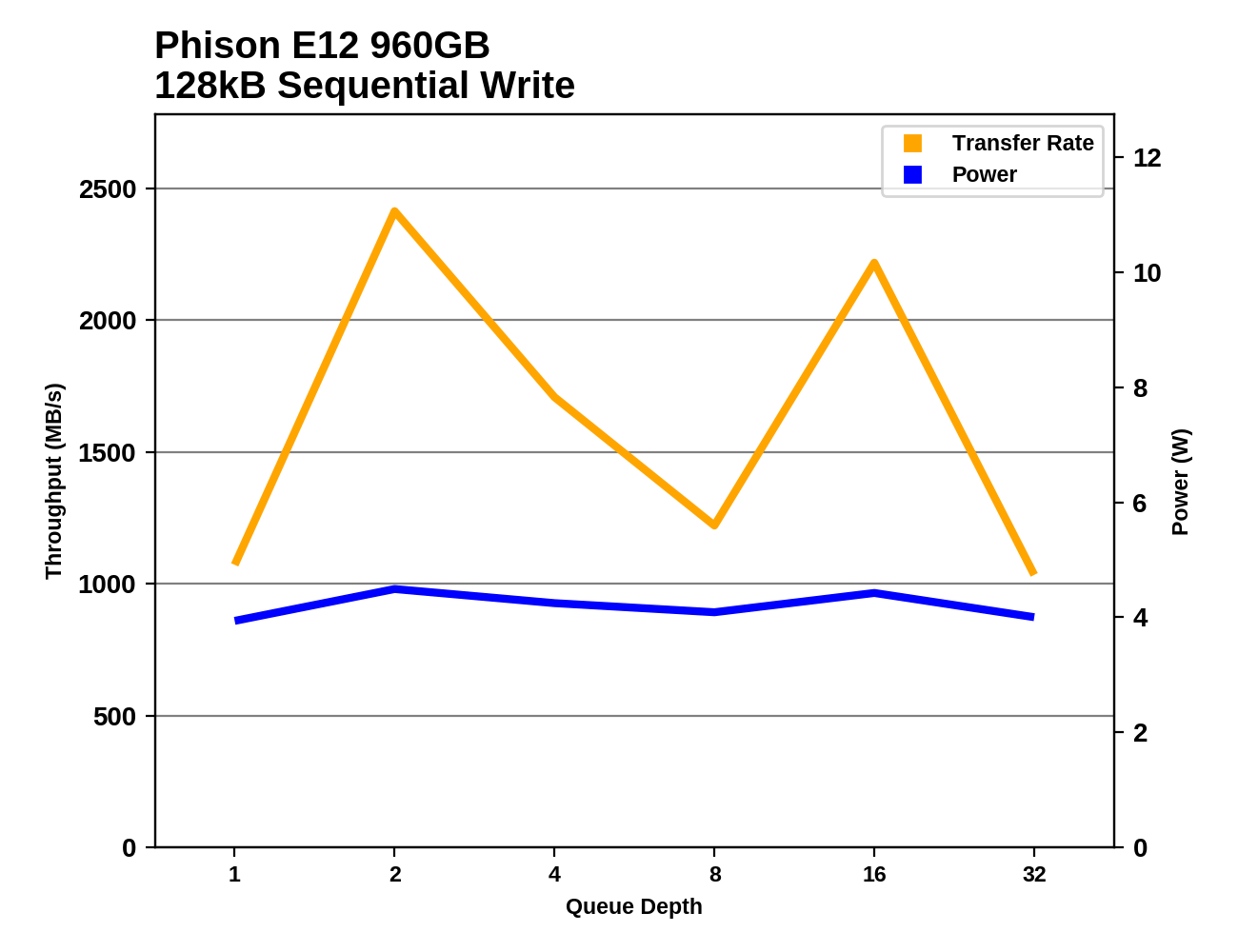The Phison E12 Reference Design Preview: A Next-Gen NVMe SSD Controller
by Billy Tallis on July 18, 2018 10:30 AM ESTSequential Read Performance
Our first test of sequential read performance uses short bursts of 128MB, issued as 128kB operations with no queuing. The test averages performance across eight bursts for a total of 1GB of data transferred from a drive containing 16GB of data. Between each burst the drive is given enough idle time to keep the overall duty cycle at 20%.

The burst sequential read performance of the Phison E12 is just shy of 2GB/s—much better than most TLC SSDs, but the HP EX920 has a pretty big lead at 2.4GB/s.
Our test of sustained sequential reads uses queue depths from 1 to 32, with the performance and power scores computed as the average of QD1, QD2 and QD4. Each queue depth is tested for up to one minute or 32GB transferred, from a drive containing 64GB of data. This test is run twice: once with the drive prepared by sequentially writing the test data, and again after the random write test has mixed things up, causing fragmentation inside the SSD that isn't visible to the OS. These two scores represent the two extremes of how the drive would perform under real-world usage, where wear leveling and modifications to some existing data will create some internal fragmentation that degrades performance, but usually not to the extent shown here.

On the longer sequential read test, the Phison E12 doesn't keep pace, and it isn't even the fastest controller for this kind of NAND: the Toshiba XG5 is a bit faster. The E12's performance doesn't suffer acutely from internal fragmentation like the SM2262-based HP EX920 does.
 |
|||||||||
| Power Efficiency in MB/s/W | Average Power in W | ||||||||
The Phison E12 is reasonably power efficient on the sequential read test, but it doesn't stand out from the crowd. It is one of the few drives that draws more power when reading from a data with internal fragmentation, because that fragmentation slows most drives down to the point that they also start drawing less power overall.
 |
|||||||||
The sequential read performance of the Phison E12 is mostly flat at low queue depths, and then jumps up toward saturation between QD4 and QD16. There are several other drives that require similarly high queue depths to reach full performance, but the HP EX920 does more than 3 GB/s at QD2.
Sequential Write Performance
Our test of sequential write burst performance is structured identically to the sequential read burst performance test save for the direction of the data transfer. Each burst writes 128MB as 128kB operations issued at QD1, for a total of 1GB of data written to a drive containing 16GB of data.

After seeing the Phison E12 set a record for burst random writes, it is not too surprising to see it also set the record for burst sequential write performance. Second place goes to the Samsung 970 EVO, and then it's a long way down to the next fastest TLC drive.
Our test of sustained sequential writes is structured identically to our sustained sequential read test, save for the direction of the data transfers. Queue depths range from 1 to 32 and each queue depth is tested for up to one minute or 32GB, followed by up to one minute of idle time for the drive to cool off and perform garbage collection. The test is confined to a 64GB span of the drive.

On the longer sequential write test, the Phison E12 doesn't hold on to its performance as well as the Samsung 970 EVO does, but the E12 still manages to stay ahead of the rest of the TLC drives.
 |
|||||||||
| Power Efficiency in MB/s/W | Average Power in W | ||||||||
Several SSDs with BiCS3 3D TLC take the top spots for power efficiency during sequential writes. The Toshiba XG5 is still on top, but the Phison E12 ties the WD Black for second place. The E12 uses a bit more power than the WD Black but delivers speed to match.
 |
|||||||||
The Phison E12 hits an excellent sequential write speed at QD2, but then bounces around as the drive struggles to complete garbage collection to empty the SLC cache during the idle times between test phases. The drive still stays above 1GB/s, so it isn't slowing down to anywhere near SATA speeds. Power consumption varies little; the drive is 100% busy writing to the flash throughout the test phases, even when a significant portion of those writes aren't new data coming in from the host system.










28 Comments
View All Comments
Tastydirt - Sunday, August 5, 2018 - link
Not necessarily, depending on workload. A drive like this will read/write 4-8x faster than a SATA drive, allowing it to drop back into idle state much faster. This would probably result in lower total power consumption per byte read.DanNeely - Wednesday, July 18, 2018 - link
looks like a solid design to me, no bad results anywhere and optimizing for low latency over peak throughput in consumer scenarios is probably the better choice.takeshi7 - Wednesday, July 18, 2018 - link
I wish they kept the flip chip BGA design of the E7. It just looks cooler with the exposed die.imaheadcase - Wednesday, July 18, 2018 - link
Plan on admiring it inside case huh?FATCamaro - Wednesday, July 18, 2018 - link
He’s going to watch all those bits moving around the chip.Alistair - Wednesday, July 18, 2018 - link
A nice new possibility, but like the HP drive surprised me when I opened it, the Phison is double-sided unfortunately. I'd rather not buy Samsung, but Samsung being single-sided is a big plus.imaheadcase - Wednesday, July 18, 2018 - link
A big plus for what?DanNeely - Wednesday, July 18, 2018 - link
compatibility with laptops that don't have enough Z height for a 2 sided m.2 card.romrunning - Thursday, July 19, 2018 - link
It can also help with the cooling, if the controller is being impacted by higher thermals. The board-facing side may not have enough space to add even a small heatsink. Single-sided M.2 drives can benefit from placing the heatsink on the top side, along with whatever better airflow there may be the top side as well.siuol11 - Wednesday, July 18, 2018 - link
I really wish someone besides Samsung would make a "performance" drive with MLC, I'm not interested in using a TLC drive for a windows install. AFAIK there are no direct competitors to Samsung's Pro drives, and the prices have consequently continued to stay high.